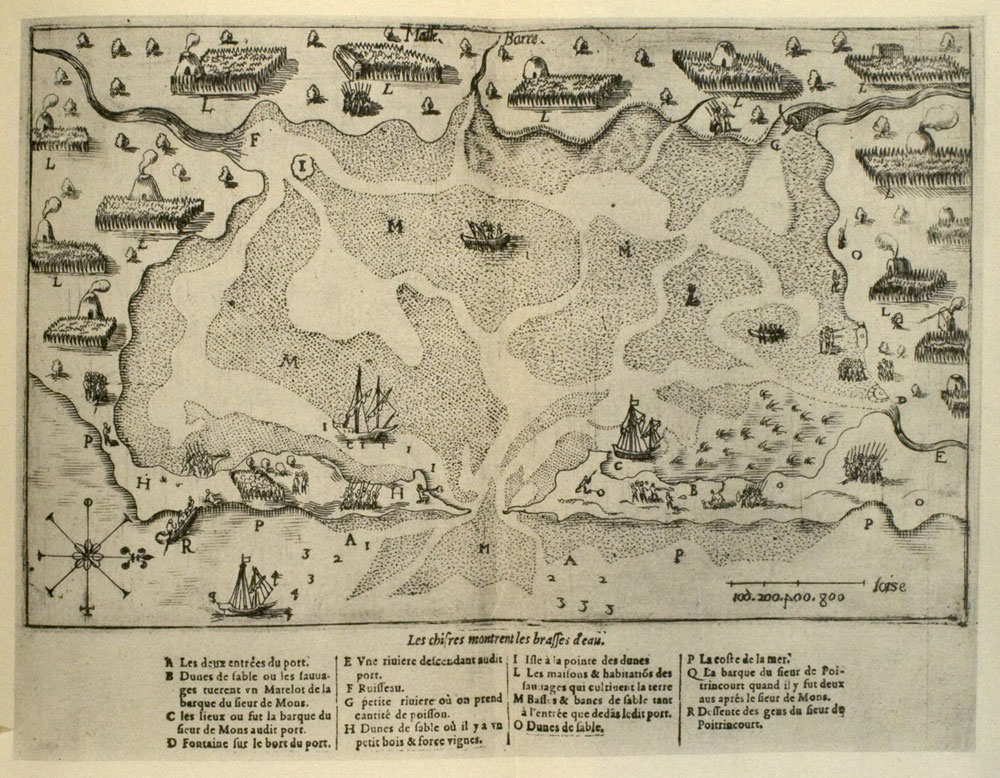After de Monts and Chaplain’s pleasant visit with the farmers of Saco Bay, they continued south to Cape Ann. Here they encountered another dense population of agricultural people, who also treated them warmly. Champlain recorded that they “saw a canoe containing five or six savages, who came out near our barque, and then went back and danced on the beach. Sieur de Monts sent me on shore to observe them, and to give each one of them a knife and some biscuit, which caused them to dance again better than before … The savages told us that all those inhabiting this country cultivated the land and sowed seeds like the others, whom we had before seen …. Sailing half a league farther, we observed several savages on a rocky point, who ran along the shore, dancing as they went, to their companions to inform them of our coming. After pointing out to us the direction of their abode, they made a signal with smoke to show us the place of their settlement. We anchored near a little island [Thatchers Island] and sent our canoe with knives and cakes for the savages … We saw here a great many little houses, scattered over the fields where they plant their Indian corn” (Grant, 1907: 67)
As they continued south, they had many more positive interactions with the Amerindians, until things turned ugly at what they named Port de Mallebarre (“Port of Dangerous Shoals” – now Nauset Harbor). De Monts, with nine or ten others (including Champlain), may have instigated the whole affair when they went tromping through fields of flowering corn, tobacco, beans, and squash. As they passed through, they helped themselves freely to the bounty without asking permission, surely riling the inhabitants.
On the 23rd of July, the French had a deadly skirmish with the local Nauset people. As de Champlain relates: “four or five seamen having gone on shore with some kettles to get fresh water, some of the savages, coveting them, watched the time when our men went to the spring, and then seized one out of the hands of a sailor, who was the first to dip, and who had no weapons. One of his companions, starting to run after him, soon returned, as he could not catch him, since he ran much faster than himself. The other savages, of whom there was a large number, seeing our sailors running to our barque, and at the same time shouting to us to fire at them, took to flight. At the time there were some of them in our barque, who threw themselves into the sea, only one of whom we were able to seize. Those on the land who had taken to flight, seeing them swimming, returned straight to the sailor from whom they had taken away the kettle, hurled several arrows at him from behind, and brought him down. Seeing this, they ran at once to him and dispatched him with their knives. Meanwhile, haste was made to go on shore, and muskets were fired from our barque: mine, bursting in my hands, came near killing me.
The savages, hearing this discharge of firearms, took to flight, and with redoubled speed when they saw that we had landed, for they were afraid when they saw us running after them. There was no likelihood of our catching them, for they are as swift as horses. We brought in the murdered man, and he was buried some hours later. Meanwhile, we kept the prisoner bound by the feet and hands on board of our barque, fearing that he might escape. But Sieur de Monts resolved to let him go, being persuaded that he was not to blame and that he had no previous knowledge of what had transpired … “Some hours later there came some savages to us, to excuse themselves, indicating by signs and demonstrations that it was not they who had committed this malicious act, but others farther off in the interior. We did not wish to harm them, although it was in our power to avenge ourselves.” (Biggar, 1922: 353-354)
This encounter may have signaled a difference in attitude between the Abenaki in the relatively unsettled north and the Nauset in the more densely settled south. McManamon (2022) points out that: “the French were seeking a settlement located in an area that was already densely occupied … Vacant land in these locations might have been scarce, mainly fallow land set aside for subsequent use when their fertility was replenished. Such land would not have been available for new settlers to set up trading colonies or residences.”
It is also possible that the Nauset were reacting to previous insults from Europeans. In 1524, Giovanni Verrazano marched through the countryside of North Carolina and abducted a small boy. An English colony at Roanoke, North Carolina became “lost” in 1585 after the visitors burned down a village and fowled the corn of the locals. The Nauset had just recently been visited at Cape Cod by Bartholomew Goswald in 1602 and Martin Pring in 1603. Both these expeditions ended with major confrontations, although the causes were unreported.
At any rate, after their ugly skirmish with the Nauset, de Monts and Champlain decided it was time the go back to St. Croix. They had worn out their welcome, did not relish any more conflict and their supplies were getting dangerously low.
Figure: Champlain’s 1607 drawing of Nauset Harbor
Bibliography:
Bigger, H. P. (1922) The works of Samuel de Champlain. Volume 1: 1599 – 1607. The Champlain Society: Toronto.
Grant, W. L. (ed.) (1907) Voyages of Samuel de Champlain 1604 – 1618. Charles Scribner’s Sons, New York.
McManamon F.P. (2022)The French Along the Northeast Coast—1604-1607, Saint Croix Island International Historic Site. National Park Service, Boston, MA.
Related blog:
